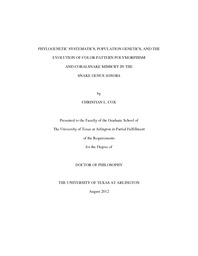
ATTENTION: The works hosted here are being migrated to a new repository that will consolidate resources, improve discoverability, and better show UTA's research impact on the global community. We will update authors as the migration progresses. Please see MavMatrix for more information.
Show simple item record
| dc.contributor.author | Cox, Christian L. | en_US |
| dc.date.accessioned | 2013-03-20T19:12:03Z | |
| dc.date.available | 2013-03-20T19:12:03Z | |
| dc.date.issued | 2013-03-20 | |
| dc.date.submitted | January 2012 | en_US |
| dc.identifier.other | DISS-11804 | en_US |
| dc.identifier.uri | http://hdl.handle.net/10106/11577 | |
| dc.description.abstract | Mimicry is a widespread biological phenomenon and is simply defined as the resemblance of one organism to another for some sort of protective purpose. Specifically, Batesian mimicry occurs when a harmless species imitates a noxious or harmful species. Neotropical coralsnakes and their colubrid snake mimics are a very diverse example of Batesian mimicry and coralsnake mimicry has been posited as a major factor underlying the diversity of Neotropical colubrids. One type of phenotypic diversity that is widespread among Neotropical coralsnake mimics is geographic variation in color and color pattern polymorphism. Color pattern polymorphism is the presence of multiple color pattern types within the same population for the same species. Although common within coralsnake mimics and within other Batesian mimicry complexes, the evolutionary conditions underlying the evolution of color pattern polymorphism in the context of mimicry is not well understood. My dissertation research focuses on the evolutionary dynamics of color pattern polymorphism within a group of Neotropical coralsnake mimics in the genus Sonora. This genus contains four species that are distributed from the Balsas region of Mexico to central North America and all possess striking color pattern polymorphism. The three exclusively Mexican species are found entirely in sympatry with coralsnake species and have multiple coralsnake-mimicking morphs. In contrast, the North American S. semiannulata has the largest geographic range (including large areas of allopatry with coralsnakes) and has only one mimetic morph (and 3 other morphs). I use a combination of extensive museum sampling, phylogenetic systematics, population genomics, and candidate gene approaches to assess relationships among population and species, determine the selection dynamics on color pattern, and assess the genetic origin of color pattern polymorphism. This research reveals the phylogenetic distribution of coralsnake mimicry and color pattern polymorphism, geographic and temporal variation in selection on color pattern, and suggests future avenues of research for assessing the genetic determinants of color pattern. | en_US |
| dc.description.sponsorship | Chippindale, Paul | en_US |
| dc.language.iso | en | en_US |
| dc.publisher | Biology | en_US |
| dc.title | Phylogenetic Systematics, Population Genetics, And The Evolution Of Color Pattern Polymorphism And Coralsnake Mimicry In The Snake Genus Sonora | en_US |
| dc.type | Ph.D. | en_US |
| dc.contributor.committeeChair | Chippindale, Paul | en_US |
| dc.degree.department | Biology | en_US |
| dc.degree.discipline | Biology | en_US |
| dc.degree.grantor | University of Texas at Arlington | en_US |
| dc.degree.level | doctoral | en_US |
| dc.degree.name | Ph.D. | en_US |
Files in this item
- Name:
- Cox_uta_2502D_11804.pdf
- Size:
- 6.017Mb
- Format:
- PDF
This item appears in the following Collection(s)
Show simple item record


